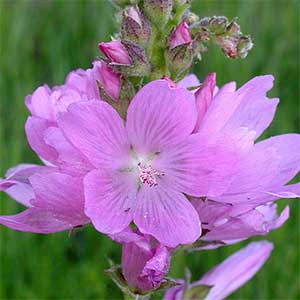Sidalcea oregana var. calva
Sidalcea oregana subsp. hydrophila
Oregon checkermallow
marsh checkerbloom, meadow checkerbloom, Oregon checkerbloom
decumbent-based, often rooting, branched or not, solid or hollow near base in age, usually to 5 mm diam. near base, base stellate-bristly or hirsute, bristle hairs 2 mm.
stipules linear or lanceolate, 4–6(–9) × 0.5–1 mm;
petioles of basal leaves (5–)10–20(–30) cm, 3–4+ times as long as blade, reduced distally and distalmost leaves longer than mature inflorescence;
bracts linear, undivided, 4–6 mm, sometimes longer than young flower buds, much longer than pedicels, shorter than calyx.
1–2 mm.
bisexual, sometimes also unisexual and pistillate, plants gynodioecious;
calyx 6–8 mm, stellate-puberulent, not bristly;
petals bright pink, 8–12 mm;
staminal column 4–6 mm, hairy;
anthers white;
stigmas 7–9.
1.5–2 mm.
4–5 mm diam.;
mericarps 7–9, 2–2.5 mm, usually glabrous or sparsely glandular-puberulent on back, smooth, mucro 0.3 mm.
= 20.
Sidalcea oregana var. calva
Sidalcea oregana subsp. hydrophila
Of conservation concern.
Subspecies hydrophila is generally recognized by its few-flowered, compact, terminal, headlike spikes in branched inflorescences; its long bristles on the proximal stems; and its high wet mountain-meadow habitat. It intergrades somewhat with subsp. spicata. Similar plants, possibly referable to subsp. hydrophila, have been found near Spooner Lake in Douglas County, Nevada. Subspecies valida also has compact spicate inflorescences, but it can be distinguished by its longer spikes, greater flower number, thicker stems with stellate hairs, and marshy habitat at lower elevations. Subspecies hydrophila occurs in the high and inner North Coast Ranges in Colusa, Glenn, Lake, Mendocino, and Napa counties, California, and possibly in Douglas County, Nevada.
(Discussion copyrighted by Flora of North America; reprinted with permission.)
- Local floras:
WA
- Local Web sites:
Flora NW,
PNW Herbaria
WildflowerSearch
iNaturalist (observations)
- LBJ Wildflower Center
- SEINet
- Plants of the World Online
- Encyclopedia of Life
- Wikipedia
- Google Image Search


